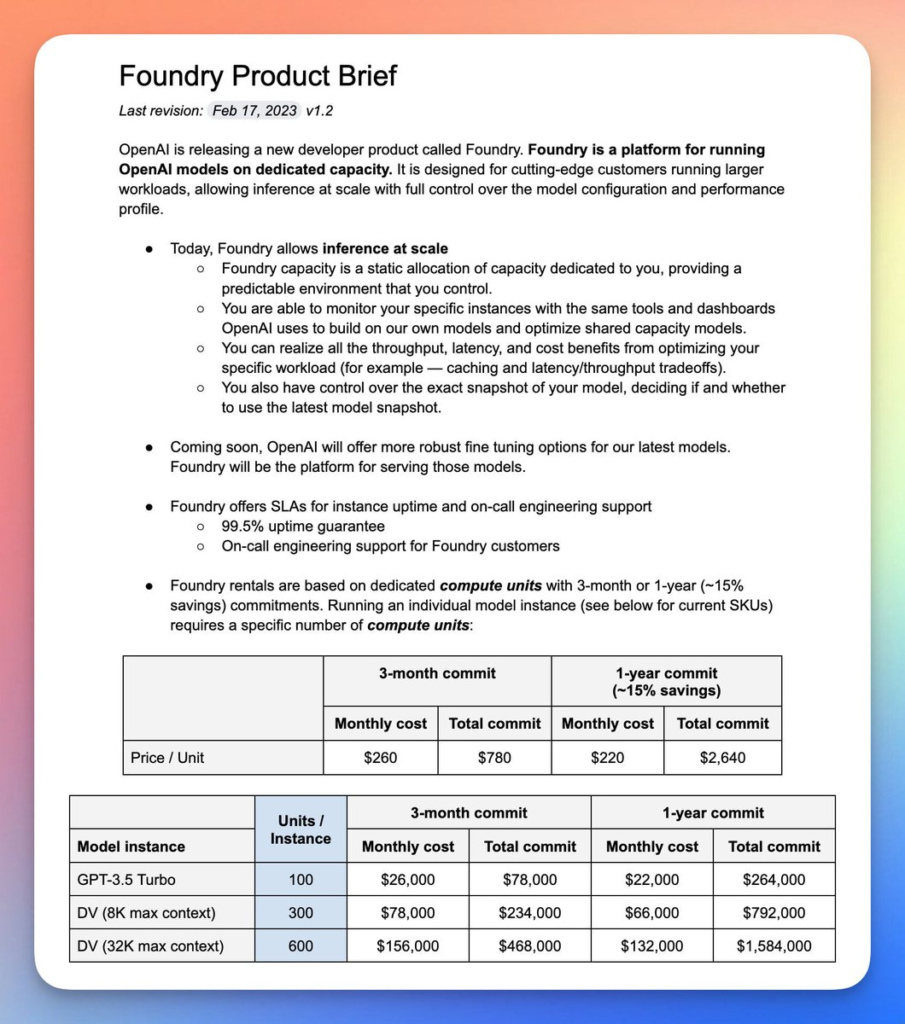This post is a second version of the map drawn on the post Microsoft, Google, Chat GPT, Bard and other things.
The pricing table
Last week a pricing deck of OpenAI models have been leaked, and it’s an interesting information to understand what is potentially coming on the prompt industry.

So in a nutshell:
- Foundry is the platform for serving OpenAI’ s models (different versions of ChatGPT, DaVinci…).
- On the list of models above, all are ChatGPT. The different versions of ChatGPT3 are: DaVinci, Curie, Babbage and Ada. I would not be surprised that other OpenAI products follow the same pricing priciples.
- Foundry is a product for developers: people that will add concrete context (data) and configure the fine-tuning options of the procured models.
- The pricing sheet reveal the product is offered in service model: you rent the use of the algorithm and the compute to execute it.
How are the new versions of the algorithm going to be released?
The service model approach made me ask me some questions around how the lifecycle of the algorithm for the OpenAI’ s clients.
- How is the algorithm going to be released?
- How this is going to affect to the development work done by the clients?
- How closed/opened is going to be the code of the models for the clients?
The updated Wardley Map
Below you can find the updated original map to increase the view of the landscape.

These are the changes with respect the original map:
- Have replaced the pipeline ChatGPT by OpenAI.
- Have added Prometheus as the version of the ChatGPT used by Bing.
- Have added “business” as other relevant user.
- Have added Foundry as component to be consumed by development teams (business). I have doubts about the position I have placed the component.
- Added DaVinci, as a service that is already offered to the copywriters (I missed this component in the past).
- Added “tokens” as a potential way to monetize the use of Prompts by users.
- Added “subscription/tokens” as the way the users can use DaVinci, and hence it’s the way OpenAI monetizes it.
AI Models served through APIs
The products offered to developers on the OpenAI Foundry can be consumed through the APIs.
These are the existing guides that cover the main initiatives you can build:

It’s important to remember that phrases and words are divided in tokens. Here you can see how much tokens a sentence have.
Gameplays
Here I want to stop on some gameplays we can see on the current scenario.
- First mover: OpenAI is accelerating the move of their capabilities and right now is the first mover on this new land.
- Differentiation: they have new generation of products, and the market is already seen it as different.
- Raising barriers to entry: the use of a platform for serving these capabilities have different purposes, one of them is to build a moat that can be exploited for years.
- Price policy: I will review this point below, under “pricing power” header.
- Press release process: the leak of this news must be devastating for the competitors, specially for the big ones. In addition to that this is a clear message for the clients: these are the rules of this new environment, do you want to play in the innovative arena or you prefer to be seen as legacy?
- Co-operation: the alliance with Microsoft is a good way to visualize the capabilities to the end users. Someone can say that Microsoft is highly invested on OpenAI and it’s just materializing the investing they did. Yes, you are right, but this gives OpenAI a credibility that increases its value in many aspects.
- Education: the users, developers are using the reference of OpenAI products for learning, this is quite important for building a brand and building capabilities that can be used by others. Education is one of the key catalysts in the spread of innovation. Link to Quick Start.
- Reinforcing competitor inertia: Google is going to be flooded of content created by OpenAI DaVinci very soon and this is going to increase the need to index and they are going to offer to their clients a worse quality in terms of content. This reinforces their inertia. They can have the temptation of creating filters and capabilities to detect “AI generated” content, and this will reinforce the inertia too. Twitter, LinkedIn, Meta, Substack, Medium…. can also be affected by the appearance of “AI generated” content.
- Sapping: the leaked news about the developer product based on a service changes the way the competitors see the landscape and forces them to review and adapt their plans.
Pricing power
One of the popular phrases of Warren Buffett is around pricing power:
The single most important decision in evaluating a business is pricing power. If you’ve got the power to raise prices without losing business to a competitor, you’ve got a very good business. And if you have to have a prayer session before raising the price by 10 percent, then you’ve got a terrible business.
Warren Buffett
OpenAI at this moment is the first player moving capabilities to enable customers to satisfy current and future needs. There’s right now no other player on the scene. This gives them a temporal opportunity to define prices and create an anchor on the clients and the competitors.
Do you identify other gameplay being played right now?